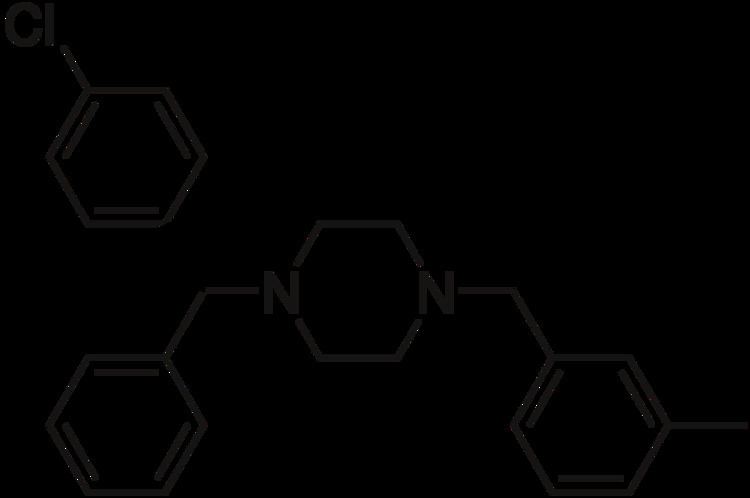MedlinePlus a682548 Metabolism CAS ID 569-65-3 | ATC code R06AE05 (WHO) Molar mass 390.948 g/mol | |
 | ||
Pregnancycategory US: B (No risk in non-human studies) Routes ofadministration Oral, sublingual/buccal Legal status AU: S4 (Prescription only)CA: OTCUS: OTC | ||
Meclizine (INN, or meclozine) is an antihistamine considered to be an antiemetic. It is sold under the brand names Bonine, Bonamine, Antivert, Postafen, Sea Legs, and Dramamine II (Less Drowsy Formulation). Emesafene is a combination of meclizine (1/3) and pyridoxine (2/3). In Canada, Antivert Tab (which is no longer available) was a combination of meclizine and nicotinic acid.
Contents
Classification
Meclizine is a first-generation antihistamine (nonselective H1 antagonist) of the piperazine class. It is structurally and pharmacologically similar to buclizine, cyclizine, and hydroxyzine, but has a shorter half-life of six hours compared to cyclizine and hydroxyzine with about 20 hours (though half-life should not be confused with duration). It is used as an antivertigo/antiemetic agent, specifically in the prevention and treatment of nausea, vomiting, and dizziness associated with motion sickness. Meclizine is sometimes combined with opioids, especially ones of the open-chain class like methadone, dextropropoxyphene, and dipipanone (originally combined with meclizine's parent drug cyclizine, the brand name of this combination is Diconal).
Mechanism of action
Meclizine is an antagonist at H1 receptors. It possesses anticholinergic, central nervous system depressant, and local anesthetic effects. Its antiemetic and antivertigo effects are not fully understood, but its central anticholinergic properties are partially responsible. The drug depresses labyrinth excitability and vestibular stimulation, and it may affect the medullary chemoreceptor trigger zone. Meclizine also is a dopamine antagonist at D1-like and D2-like receptors, but does not cause catalepsy in mice, perhaps because of its anticholinergic activity.
Uses
Meclizine is approved by the U.S. Food and Drug Administration (FDA) to treat symptoms of motion sickness. Meclizine's safety and efficacy in children younger than 12 years old has not been established, therefore use in this population is not recommended. Also, meclizine should be taken with caution in the elderly (older than 65 years) because of increased risk of confusion and amnesia.
Motion sickness
Meclizine is effective in inhibiting the symptoms of motion sickness, such as nausea and vomiting. The recommended dose is 25–50 mg orally, taken one hour before travel.
The drug is also safe for treating nausea in pregnancy and is a first-line therapy for this use. Doxylamine is similarly safe. Meclizine may not be strong enough for especially sickening motion stimuli and second-line defenses should be tried in those cases.
Vertigo
Meclizine is not effective in relieving vertigo experienced as a result of inner ear infections or other conditions.
Side effects
Some common side effects such as drowsiness, dry mouth, and tiredness may occur. Meclizine has been shown to have fewer dry mouth side effects than the traditional treatment for motion sickness, transdermal scopolamine. A very serious allergic reaction to this drug is unlikely, but immediate medical attention should be sought if it occurs. Symptoms of a serious allergic reaction may include rash, itching, swelling, severe dizziness, and trouble breathing.
Drowsiness
Drowsiness may result as a side effect of taking meclizine. Users are advised not to operate heavy machinery while under the influence. The consumption of alcohol while under the influence of meclizine may result in additional drowsiness.
Special considerations in the elderly
As with any anticholinergic agent, meclizine may cause confusion or aggravate symptoms in those with dementia in the geriatric population (older than 65 years). Therefore, caution should be used when administering meclizine to the elderly.
Synthesis
(4-Chlorphenyl)-phenylmethanol is halogenated with thionyl chloride before adding acetylpiperazine. The acetyl group is cleaved with diluted sulfuric acid. An N-alkylation of the piperazine ring with 3-methylbenzylchloride completes the synthesis.
Alternatively, the last step can be replaced by a reductive N-alkylation with 3-methylbenzaldehyde. The reductive agent is hydrogen, and Raney nickel is used as a catalyst.
Meclizine is obtained and used as a racemate, a 1:1 mixture of the two stereoisomers. Drug forms contain the dihydrochloride.
